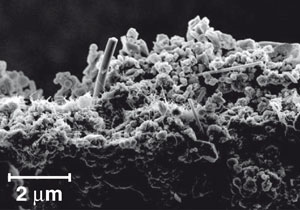A team of German researchers have reached certain positive conclusions on safety of nano-materials. The team studied nanoparticles or nanotubes of four different materials by subjecting them to gentle abrasion, high speed sanding and UV radiation, and discovered that the resulting dust was in no way finer than traditional materials.
Wendel Wohlleben and co-workers at German chemical group BASF researched two thermoplastic materials namely polyamide and polyoxymethylene (POM) and two cements incorporated with different nanostructures.
 Cement with embedded carbon nanotubes
Cement with embedded carbon nanotubes
The POM comprised carbon nanotubes (5% by weight) to reveal anti-static properties. The carbon nanotubes (2%) present in cement protected the material from high-frequency radiation. The polyamide comprised particles of silicon dioxide (4%) for high strength and the nanoparticles of calcium silicate hydrate in the second cement portion (4%) improved its hardening properties.
The researchers could not detect major emission of nanoparticles into the environment due to sanding. The dust particles were collected and chemical identities and particle size were determined using spectroscopy, microscopy, laser diffraction, filtration, and fractionation by centrifuge. The nanomaterials were not considerably smaller when compared to the control powders.
Rolling wheels were used on the materials enabling researchers to simulate the gentle abrasions of daily wear and tear. The size of the particles subjected to sanding treatment is not dependent on the nano-component content of the material. The researchers saw no variations between the plain and nano-engineered versions of cement or polyamide when under UV exposure.
The team studied small particles that could be absorbed by lung tissue to determine the biological impact of the powders. Powder suspensions were injected into the lungs of 48 rats and the rats were inspected three days following the dose and again three weeks later to detect damage to DNA or tissues. The rats did not suffer any general defects, mutagenic effects or toxicity in organs. The powders resulted in inflammation in the rat’s lungs, but the nanomaterials produced more or less the same amount of damage as traditional materials.
The study suggests that the nano-components do not increase the danger of breathing in the material. Wohlleben says that the results will be more exact with further research, but they have analyzed the risk factors of nanocomposites experimentally.